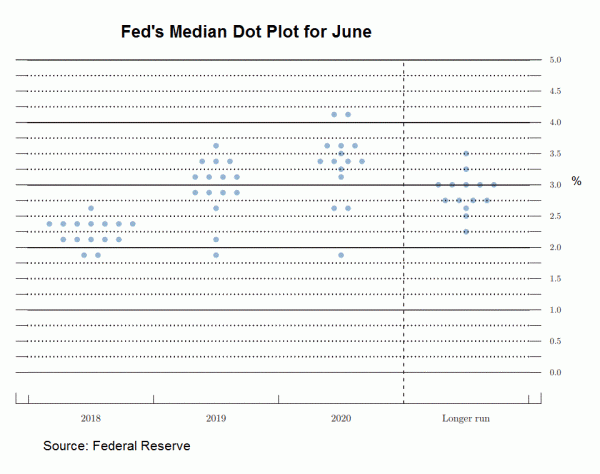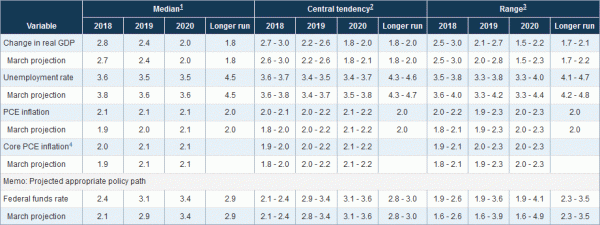Decided unanimously, FOMC raised the Fed funds rate by +25 bps to a range of 1.75-2.00%. In a technical adjustment, it also lifted the interest rate paid on required and excess reserve balances, by +20 bps, to 1.95% so as to maintain the trading in the fed funds market at rates well within the FOMC’s target range. Certainly, the focuses are on the indication on the future rate hike path and economic projections. The members are more upbeat on the economic developments since the last meeting, noting “solid” growth, compared with “moderate” growth in the prior meeting. The staff upgraded the GDP growth forecast for this year and inflation outlook for this year and 2019. The median dot plot suggests 2 more rate hikes, one more than projected in the prior meeting.
Taking a look at the median dot plot, policymakers project the federal funds rate target to increase to 2.4% (from 2.1%) this year and to 3.1% (from 2.9%) in 2019, suggesting that the median expectation is for two more rate hikes this year. This marks one more hike than previously indicated. Expectations for the policy rate target were unchanged for 2020 and the longer run. Fed’s confidence at the current path of interest rate normalization is also exemplified in the accompanying statement, in which, as we had expected, the forward guidance is amended. In May, the Fed noted that “the economic conditions will evolve in a manner that will warrant further gradual increases in the federal funds rate; the federal funds rate is likely to remain, for some time, below levels that are expected to prevail in the longer run. However, the actual path of the federal funds rate will depend on the economic outlook as informed by incoming data”. The reference is shortened a lot, only to emphasize that “further gradual increases in the target range for the federal funds rate will be consistent with sustained expansion of economic activity, strong labor market conditions, and inflation near the Committee’s symmetric 2% objective over the medium term”.

The more hawkish tone is supported up the buoyant developments since the last meeting. Intermeeting dataflow shows that economic activity has been rising at a “solid rate”, compared with a “moderate rate” in May. On employment, “the unemployment rate has declined”, compared with staying “low” in May. Meanwhile, the growth of household spending “has picked up”, compared with “moderated” in May. Indicators of longer-term inflation expectations are little changed, on balance. In the latest staff economic projections, GDP growth is expected to accelerate to +2.8% this year, up from +2.7% estimated previously. Growth forecasts remain unchanged thereafter. On inflation, the median estimate for core PCE inflation was upgraded to +2.1% in 2018 and 2019, up from +1.9% and +2%, respectively. Moreover, the median unemployment rate forecast was revised lower to 3.6% in 2018 (from 3.8% previously) and to 3.5% in 2019 and 2020, respectively (from 3.6% previously). The long-term rate stays unchanged at 4.5%.
The Fed has turned more hawkish. Yet, the degree of hawkishness appeared to have priced in before the meeting. As a result, the USD index initially climbed higher before retreating. The greenback was mixed against major currencies. The price action was also driven by Chair Jerome Powell’s comment at the press conference that “most participants did not revise their projections”. Probably he wanted to downplayed the more upbeat “dot plot”.













